Critical Analysis: Cultural Differences and Team Member Combinations
VerifiedAdded on 2020/01/16
|17
|5562
|169
Essay
AI Summary
This essay critically discusses the statement that a good combination of team members has more influence on a multicultural team's effective functioning than cultural differences. It begins by defining culture and exploring various cultural theories, including the Geert Hofstede model and its dimensions. The essay then delves into cross-cultural management theories, emphasizing the importance of understanding cultural diversity in international business. It highlights the impacts of cultural differences on communication, customer needs, and body language. Furthermore, it outlines the advantages of multicultural teams, such as cultural awareness, employee relations, knowledge gain, and improved customer service. The essay also addresses strategies for managing conflicts and comparative management practices, ultimately arguing that while cultural differences are significant, the effective distribution of roles and a well-balanced team are crucial for success.

Individual Essay
Paraphrase This Document
Need a fresh take? Get an instant paraphrase of this document with our AI Paraphraser
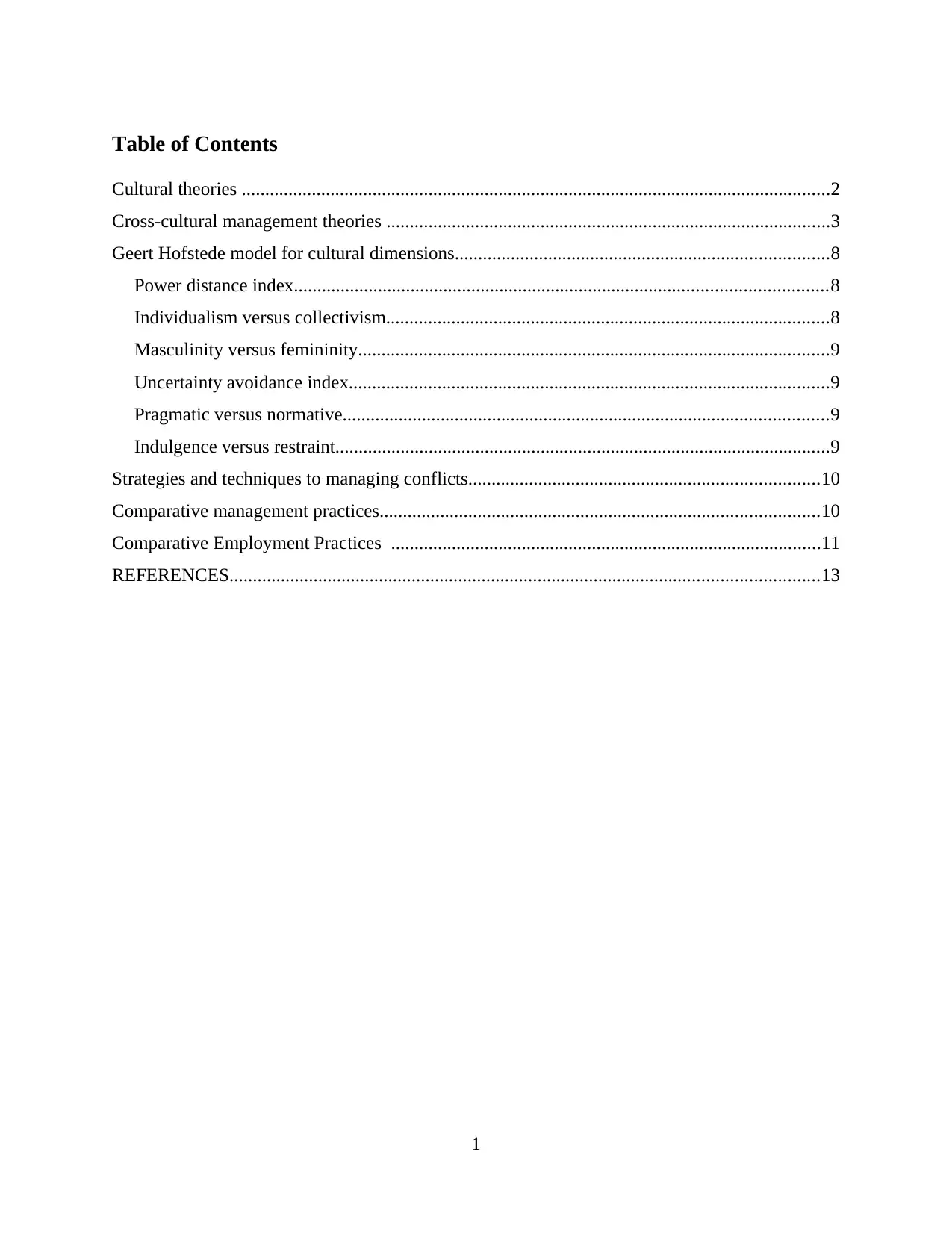
Table of Contents
Cultural theories ..............................................................................................................................2
Cross-cultural management theories ...............................................................................................3
Geert Hofstede model for cultural dimensions................................................................................8
Power distance index..................................................................................................................8
Individualism versus collectivism...............................................................................................8
Masculinity versus femininity.....................................................................................................9
Uncertainty avoidance index.......................................................................................................9
Pragmatic versus normative........................................................................................................9
Indulgence versus restraint..........................................................................................................9
Strategies and techniques to managing conflicts...........................................................................10
Comparative management practices..............................................................................................10
Comparative Employment Practices ............................................................................................11
REFERENCES..............................................................................................................................13
1
Cultural theories ..............................................................................................................................2
Cross-cultural management theories ...............................................................................................3
Geert Hofstede model for cultural dimensions................................................................................8
Power distance index..................................................................................................................8
Individualism versus collectivism...............................................................................................8
Masculinity versus femininity.....................................................................................................9
Uncertainty avoidance index.......................................................................................................9
Pragmatic versus normative........................................................................................................9
Indulgence versus restraint..........................................................................................................9
Strategies and techniques to managing conflicts...........................................................................10
Comparative management practices..............................................................................................10
Comparative Employment Practices ............................................................................................11
REFERENCES..............................................................................................................................13
1
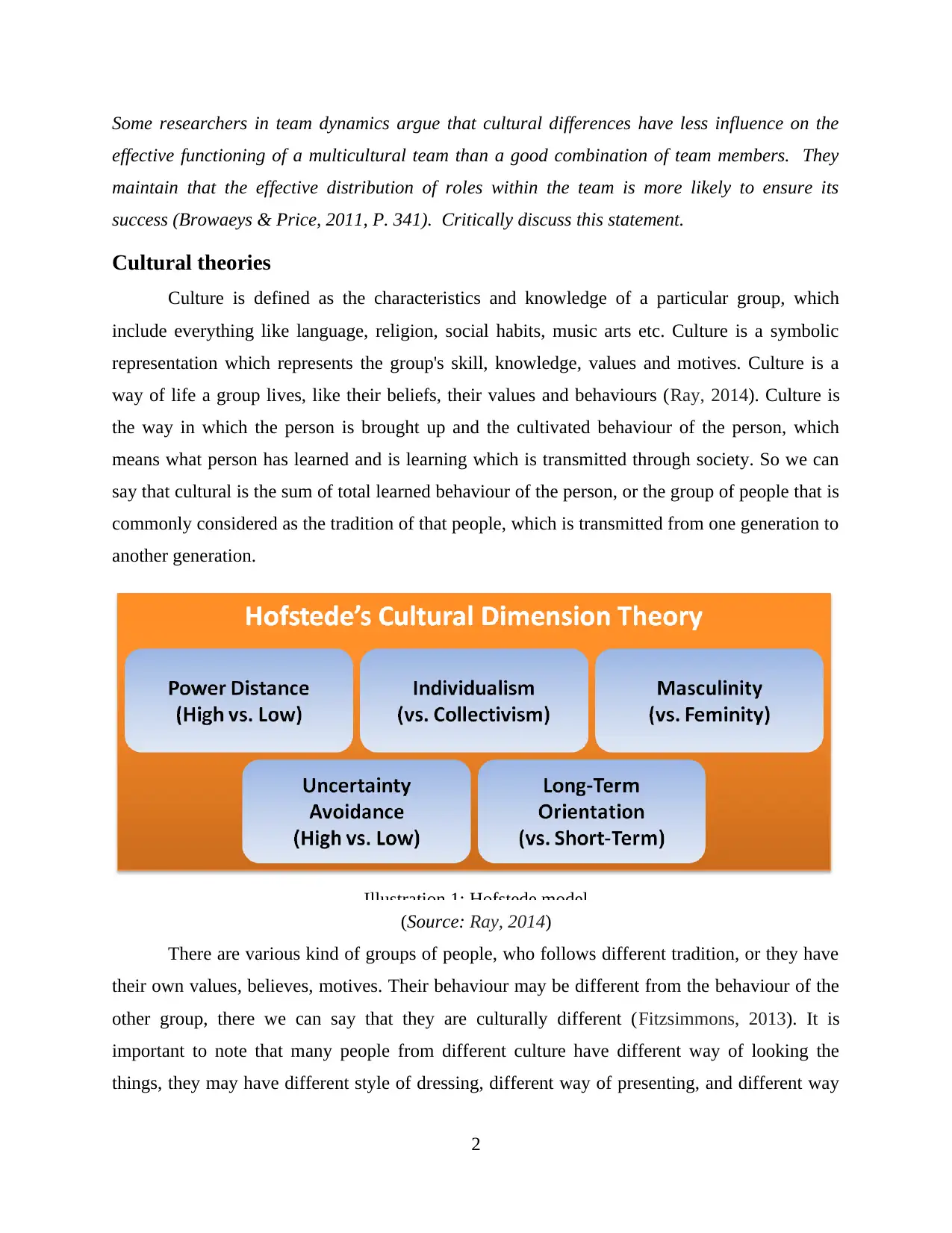
Some researchers in team dynamics argue that cultural differences have less influence on the
effective functioning of a multicultural team than a good combination of team members. They
maintain that the effective distribution of roles within the team is more likely to ensure its
success (Browaeys & Price, 2011, P. 341). Critically discuss this statement.
Cultural theories
Culture is defined as the characteristics and knowledge of a particular group, which
include everything like language, religion, social habits, music arts etc. Culture is a symbolic
representation which represents the group's skill, knowledge, values and motives. Culture is a
way of life a group lives, like their beliefs, their values and behaviours (Ray, 2014). Culture is
the way in which the person is brought up and the cultivated behaviour of the person, which
means what person has learned and is learning which is transmitted through society. So we can
say that cultural is the sum of total learned behaviour of the person, or the group of people that is
commonly considered as the tradition of that people, which is transmitted from one generation to
another generation.
Illustration 1: Hofstede model
(Source: Ray, 2014)
There are various kind of groups of people, who follows different tradition, or they have
their own values, believes, motives. Their behaviour may be different from the behaviour of the
other group, there we can say that they are culturally different (Fitzsimmons, 2013). It is
important to note that many people from different culture have different way of looking the
things, they may have different style of dressing, different way of presenting, and different way
2
effective functioning of a multicultural team than a good combination of team members. They
maintain that the effective distribution of roles within the team is more likely to ensure its
success (Browaeys & Price, 2011, P. 341). Critically discuss this statement.
Cultural theories
Culture is defined as the characteristics and knowledge of a particular group, which
include everything like language, religion, social habits, music arts etc. Culture is a symbolic
representation which represents the group's skill, knowledge, values and motives. Culture is a
way of life a group lives, like their beliefs, their values and behaviours (Ray, 2014). Culture is
the way in which the person is brought up and the cultivated behaviour of the person, which
means what person has learned and is learning which is transmitted through society. So we can
say that cultural is the sum of total learned behaviour of the person, or the group of people that is
commonly considered as the tradition of that people, which is transmitted from one generation to
another generation.
Illustration 1: Hofstede model
(Source: Ray, 2014)
There are various kind of groups of people, who follows different tradition, or they have
their own values, believes, motives. Their behaviour may be different from the behaviour of the
other group, there we can say that they are culturally different (Fitzsimmons, 2013). It is
important to note that many people from different culture have different way of looking the
things, they may have different style of dressing, different way of presenting, and different way
2
⊘ This is a preview!⊘
Do you want full access?
Subscribe today to unlock all pages.

Trusted by 1+ million students worldwide
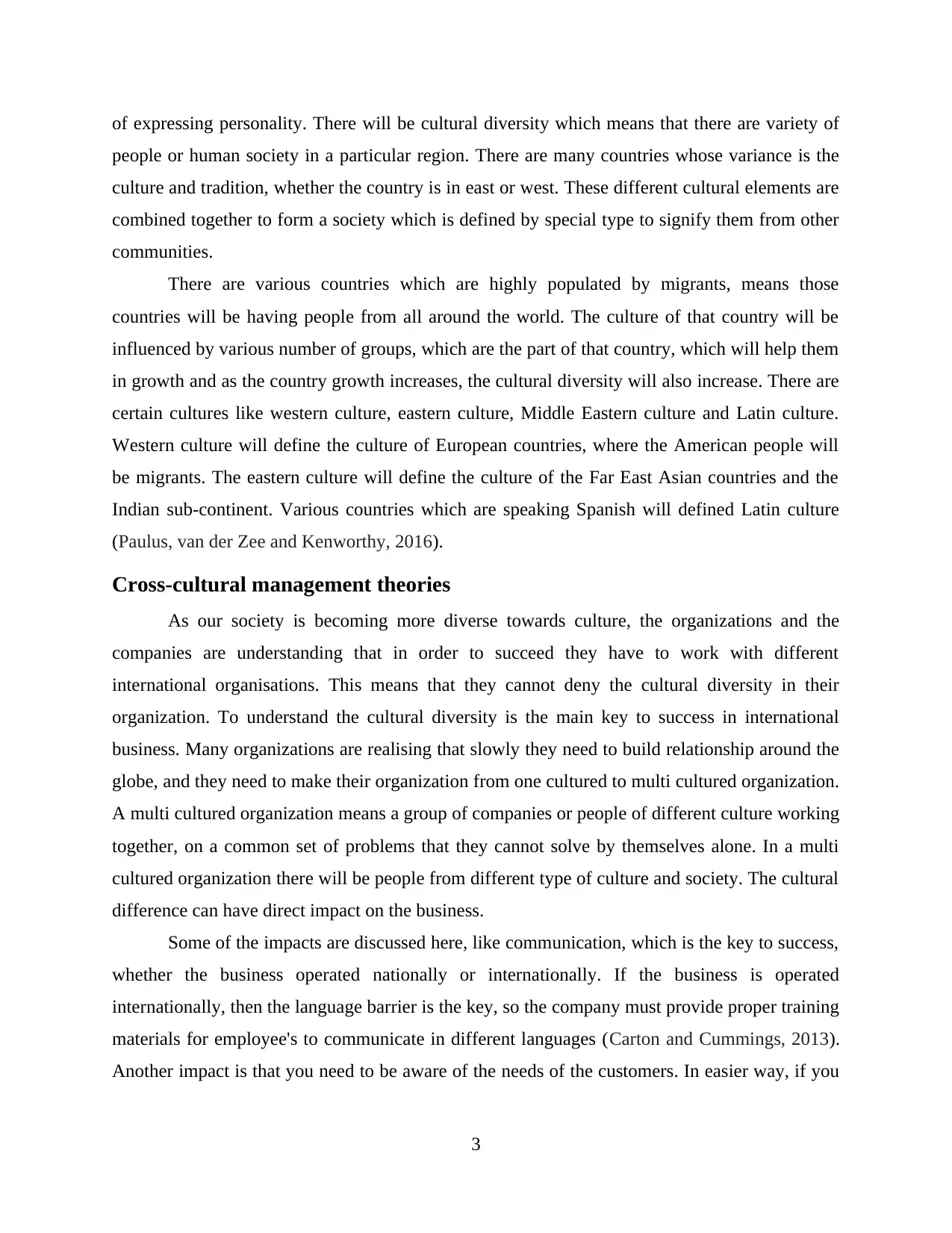
of expressing personality. There will be cultural diversity which means that there are variety of
people or human society in a particular region. There are many countries whose variance is the
culture and tradition, whether the country is in east or west. These different cultural elements are
combined together to form a society which is defined by special type to signify them from other
communities.
There are various countries which are highly populated by migrants, means those
countries will be having people from all around the world. The culture of that country will be
influenced by various number of groups, which are the part of that country, which will help them
in growth and as the country growth increases, the cultural diversity will also increase. There are
certain cultures like western culture, eastern culture, Middle Eastern culture and Latin culture.
Western culture will define the culture of European countries, where the American people will
be migrants. The eastern culture will define the culture of the Far East Asian countries and the
Indian sub-continent. Various countries which are speaking Spanish will defined Latin culture
(Paulus, van der Zee and Kenworthy, 2016).
Cross-cultural management theories
As our society is becoming more diverse towards culture, the organizations and the
companies are understanding that in order to succeed they have to work with different
international organisations. This means that they cannot deny the cultural diversity in their
organization. To understand the cultural diversity is the main key to success in international
business. Many organizations are realising that slowly they need to build relationship around the
globe, and they need to make their organization from one cultured to multi cultured organization.
A multi cultured organization means a group of companies or people of different culture working
together, on a common set of problems that they cannot solve by themselves alone. In a multi
cultured organization there will be people from different type of culture and society. The cultural
difference can have direct impact on the business.
Some of the impacts are discussed here, like communication, which is the key to success,
whether the business operated nationally or internationally. If the business is operated
internationally, then the language barrier is the key, so the company must provide proper training
materials for employee's to communicate in different languages (Carton and Cummings, 2013).
Another impact is that you need to be aware of the needs of the customers. In easier way, if you
3
people or human society in a particular region. There are many countries whose variance is the
culture and tradition, whether the country is in east or west. These different cultural elements are
combined together to form a society which is defined by special type to signify them from other
communities.
There are various countries which are highly populated by migrants, means those
countries will be having people from all around the world. The culture of that country will be
influenced by various number of groups, which are the part of that country, which will help them
in growth and as the country growth increases, the cultural diversity will also increase. There are
certain cultures like western culture, eastern culture, Middle Eastern culture and Latin culture.
Western culture will define the culture of European countries, where the American people will
be migrants. The eastern culture will define the culture of the Far East Asian countries and the
Indian sub-continent. Various countries which are speaking Spanish will defined Latin culture
(Paulus, van der Zee and Kenworthy, 2016).
Cross-cultural management theories
As our society is becoming more diverse towards culture, the organizations and the
companies are understanding that in order to succeed they have to work with different
international organisations. This means that they cannot deny the cultural diversity in their
organization. To understand the cultural diversity is the main key to success in international
business. Many organizations are realising that slowly they need to build relationship around the
globe, and they need to make their organization from one cultured to multi cultured organization.
A multi cultured organization means a group of companies or people of different culture working
together, on a common set of problems that they cannot solve by themselves alone. In a multi
cultured organization there will be people from different type of culture and society. The cultural
difference can have direct impact on the business.
Some of the impacts are discussed here, like communication, which is the key to success,
whether the business operated nationally or internationally. If the business is operated
internationally, then the language barrier is the key, so the company must provide proper training
materials for employee's to communicate in different languages (Carton and Cummings, 2013).
Another impact is that you need to be aware of the needs of the customers. In easier way, if you
3
Paraphrase This Document
Need a fresh take? Get an instant paraphrase of this document with our AI Paraphraser
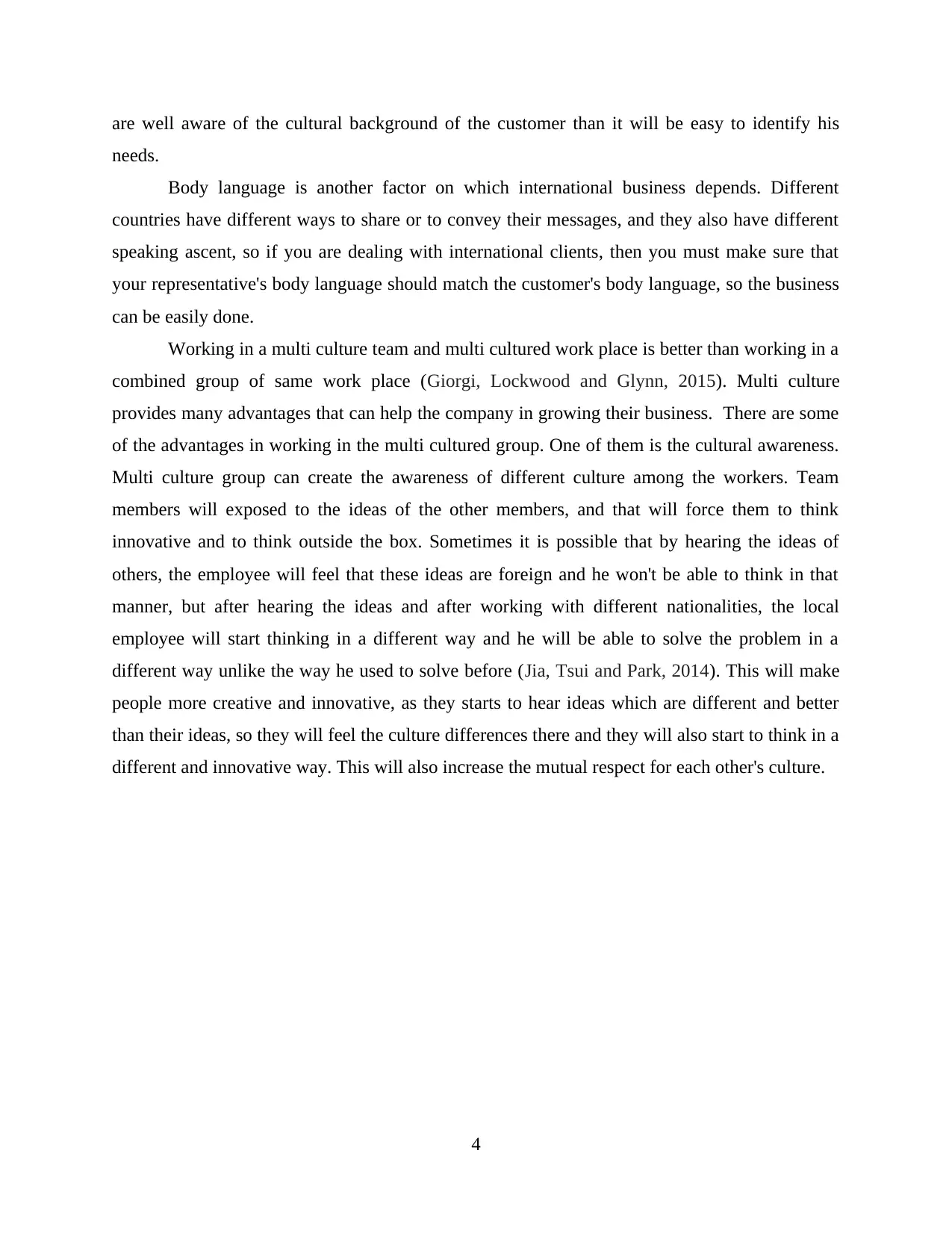
are well aware of the cultural background of the customer than it will be easy to identify his
needs.
Body language is another factor on which international business depends. Different
countries have different ways to share or to convey their messages, and they also have different
speaking ascent, so if you are dealing with international clients, then you must make sure that
your representative's body language should match the customer's body language, so the business
can be easily done.
Working in a multi culture team and multi cultured work place is better than working in a
combined group of same work place (Giorgi, Lockwood and Glynn, 2015). Multi culture
provides many advantages that can help the company in growing their business. There are some
of the advantages in working in the multi cultured group. One of them is the cultural awareness.
Multi culture group can create the awareness of different culture among the workers. Team
members will exposed to the ideas of the other members, and that will force them to think
innovative and to think outside the box. Sometimes it is possible that by hearing the ideas of
others, the employee will feel that these ideas are foreign and he won't be able to think in that
manner, but after hearing the ideas and after working with different nationalities, the local
employee will start thinking in a different way and he will be able to solve the problem in a
different way unlike the way he used to solve before (Jia, Tsui and Park, 2014). This will make
people more creative and innovative, as they starts to hear ideas which are different and better
than their ideas, so they will feel the culture differences there and they will also start to think in a
different and innovative way. This will also increase the mutual respect for each other's culture.
4
needs.
Body language is another factor on which international business depends. Different
countries have different ways to share or to convey their messages, and they also have different
speaking ascent, so if you are dealing with international clients, then you must make sure that
your representative's body language should match the customer's body language, so the business
can be easily done.
Working in a multi culture team and multi cultured work place is better than working in a
combined group of same work place (Giorgi, Lockwood and Glynn, 2015). Multi culture
provides many advantages that can help the company in growing their business. There are some
of the advantages in working in the multi cultured group. One of them is the cultural awareness.
Multi culture group can create the awareness of different culture among the workers. Team
members will exposed to the ideas of the other members, and that will force them to think
innovative and to think outside the box. Sometimes it is possible that by hearing the ideas of
others, the employee will feel that these ideas are foreign and he won't be able to think in that
manner, but after hearing the ideas and after working with different nationalities, the local
employee will start thinking in a different way and he will be able to solve the problem in a
different way unlike the way he used to solve before (Jia, Tsui and Park, 2014). This will make
people more creative and innovative, as they starts to hear ideas which are different and better
than their ideas, so they will feel the culture differences there and they will also start to think in a
different and innovative way. This will also increase the mutual respect for each other's culture.
4
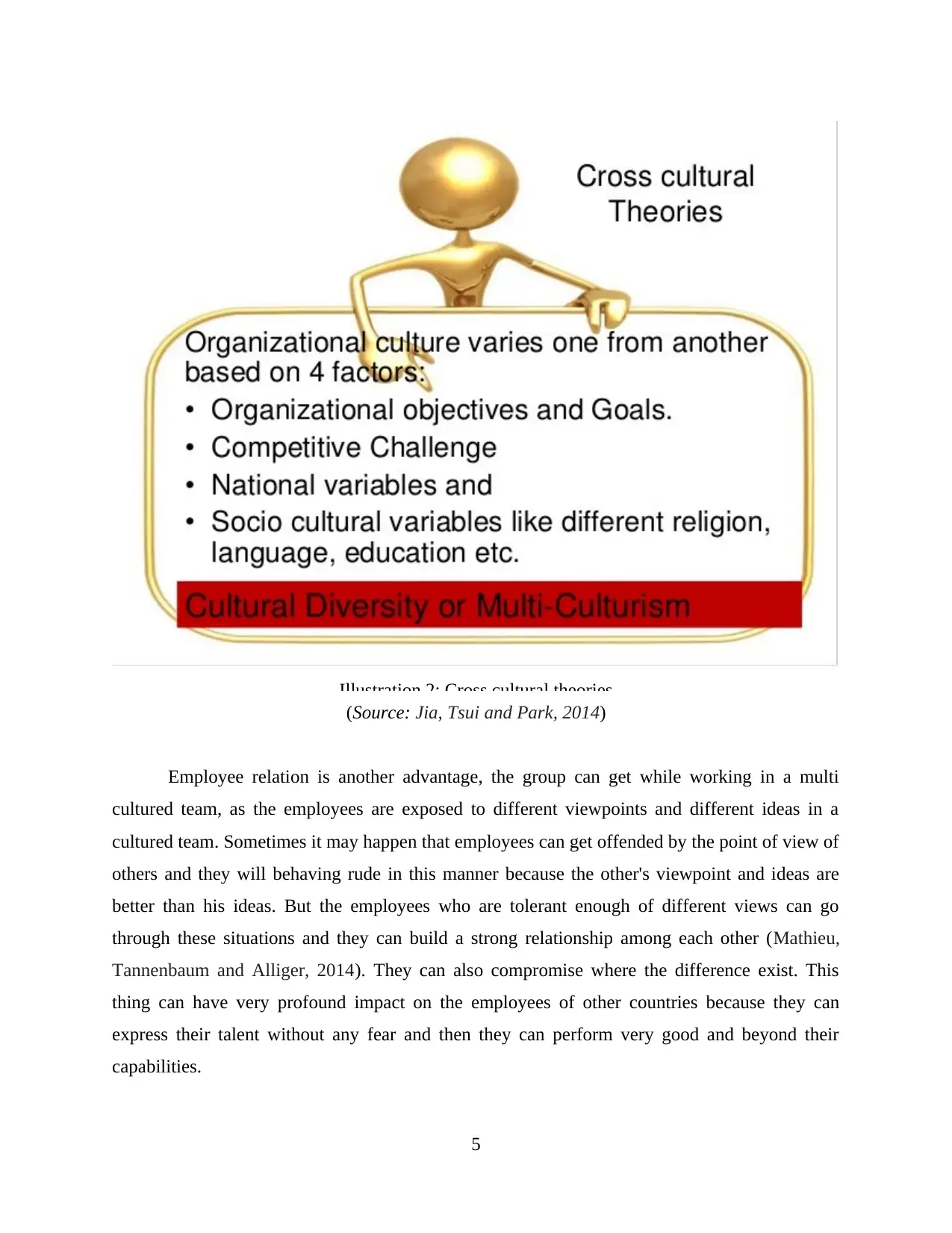
Illustration 2: Cross cultural theories
(Source: Jia, Tsui and Park, 2014)
Employee relation is another advantage, the group can get while working in a multi
cultured team, as the employees are exposed to different viewpoints and different ideas in a
cultured team. Sometimes it may happen that employees can get offended by the point of view of
others and they will behaving rude in this manner because the other's viewpoint and ideas are
better than his ideas. But the employees who are tolerant enough of different views can go
through these situations and they can build a strong relationship among each other (Mathieu,
Tannenbaum and Alliger, 2014). They can also compromise where the difference exist. This
thing can have very profound impact on the employees of other countries because they can
express their talent without any fear and then they can perform very good and beyond their
capabilities.
5
(Source: Jia, Tsui and Park, 2014)
Employee relation is another advantage, the group can get while working in a multi
cultured team, as the employees are exposed to different viewpoints and different ideas in a
cultured team. Sometimes it may happen that employees can get offended by the point of view of
others and they will behaving rude in this manner because the other's viewpoint and ideas are
better than his ideas. But the employees who are tolerant enough of different views can go
through these situations and they can build a strong relationship among each other (Mathieu,
Tannenbaum and Alliger, 2014). They can also compromise where the difference exist. This
thing can have very profound impact on the employees of other countries because they can
express their talent without any fear and then they can perform very good and beyond their
capabilities.
5
⊘ This is a preview!⊘
Do you want full access?
Subscribe today to unlock all pages.

Trusted by 1+ million students worldwide
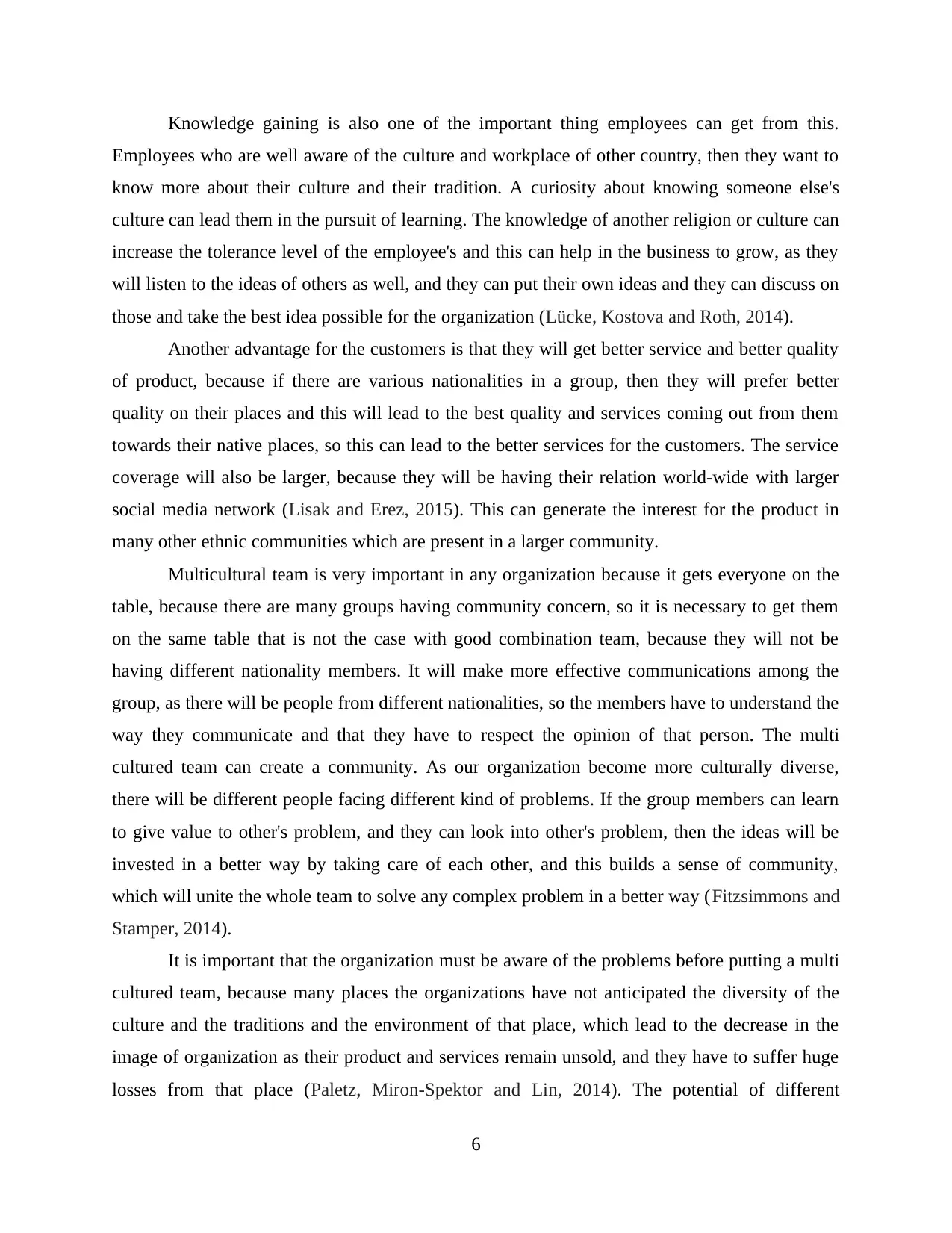
Knowledge gaining is also one of the important thing employees can get from this.
Employees who are well aware of the culture and workplace of other country, then they want to
know more about their culture and their tradition. A curiosity about knowing someone else's
culture can lead them in the pursuit of learning. The knowledge of another religion or culture can
increase the tolerance level of the employee's and this can help in the business to grow, as they
will listen to the ideas of others as well, and they can put their own ideas and they can discuss on
those and take the best idea possible for the organization (Lücke, Kostova and Roth, 2014).
Another advantage for the customers is that they will get better service and better quality
of product, because if there are various nationalities in a group, then they will prefer better
quality on their places and this will lead to the best quality and services coming out from them
towards their native places, so this can lead to the better services for the customers. The service
coverage will also be larger, because they will be having their relation world-wide with larger
social media network (Lisak and Erez, 2015). This can generate the interest for the product in
many other ethnic communities which are present in a larger community.
Multicultural team is very important in any organization because it gets everyone on the
table, because there are many groups having community concern, so it is necessary to get them
on the same table that is not the case with good combination team, because they will not be
having different nationality members. It will make more effective communications among the
group, as there will be people from different nationalities, so the members have to understand the
way they communicate and that they have to respect the opinion of that person. The multi
cultured team can create a community. As our organization become more culturally diverse,
there will be different people facing different kind of problems. If the group members can learn
to give value to other's problem, and they can look into other's problem, then the ideas will be
invested in a better way by taking care of each other, and this builds a sense of community,
which will unite the whole team to solve any complex problem in a better way (Fitzsimmons and
Stamper, 2014).
It is important that the organization must be aware of the problems before putting a multi
cultured team, because many places the organizations have not anticipated the diversity of the
culture and the traditions and the environment of that place, which lead to the decrease in the
image of organization as their product and services remain unsold, and they have to suffer huge
losses from that place (Paletz, Miron-Spektor and Lin, 2014). The potential of different
6
Employees who are well aware of the culture and workplace of other country, then they want to
know more about their culture and their tradition. A curiosity about knowing someone else's
culture can lead them in the pursuit of learning. The knowledge of another religion or culture can
increase the tolerance level of the employee's and this can help in the business to grow, as they
will listen to the ideas of others as well, and they can put their own ideas and they can discuss on
those and take the best idea possible for the organization (Lücke, Kostova and Roth, 2014).
Another advantage for the customers is that they will get better service and better quality
of product, because if there are various nationalities in a group, then they will prefer better
quality on their places and this will lead to the best quality and services coming out from them
towards their native places, so this can lead to the better services for the customers. The service
coverage will also be larger, because they will be having their relation world-wide with larger
social media network (Lisak and Erez, 2015). This can generate the interest for the product in
many other ethnic communities which are present in a larger community.
Multicultural team is very important in any organization because it gets everyone on the
table, because there are many groups having community concern, so it is necessary to get them
on the same table that is not the case with good combination team, because they will not be
having different nationality members. It will make more effective communications among the
group, as there will be people from different nationalities, so the members have to understand the
way they communicate and that they have to respect the opinion of that person. The multi
cultured team can create a community. As our organization become more culturally diverse,
there will be different people facing different kind of problems. If the group members can learn
to give value to other's problem, and they can look into other's problem, then the ideas will be
invested in a better way by taking care of each other, and this builds a sense of community,
which will unite the whole team to solve any complex problem in a better way (Fitzsimmons and
Stamper, 2014).
It is important that the organization must be aware of the problems before putting a multi
cultured team, because many places the organizations have not anticipated the diversity of the
culture and the traditions and the environment of that place, which lead to the decrease in the
image of organization as their product and services remain unsold, and they have to suffer huge
losses from that place (Paletz, Miron-Spektor and Lin, 2014). The potential of different
6
Paraphrase This Document
Need a fresh take? Get an instant paraphrase of this document with our AI Paraphraser
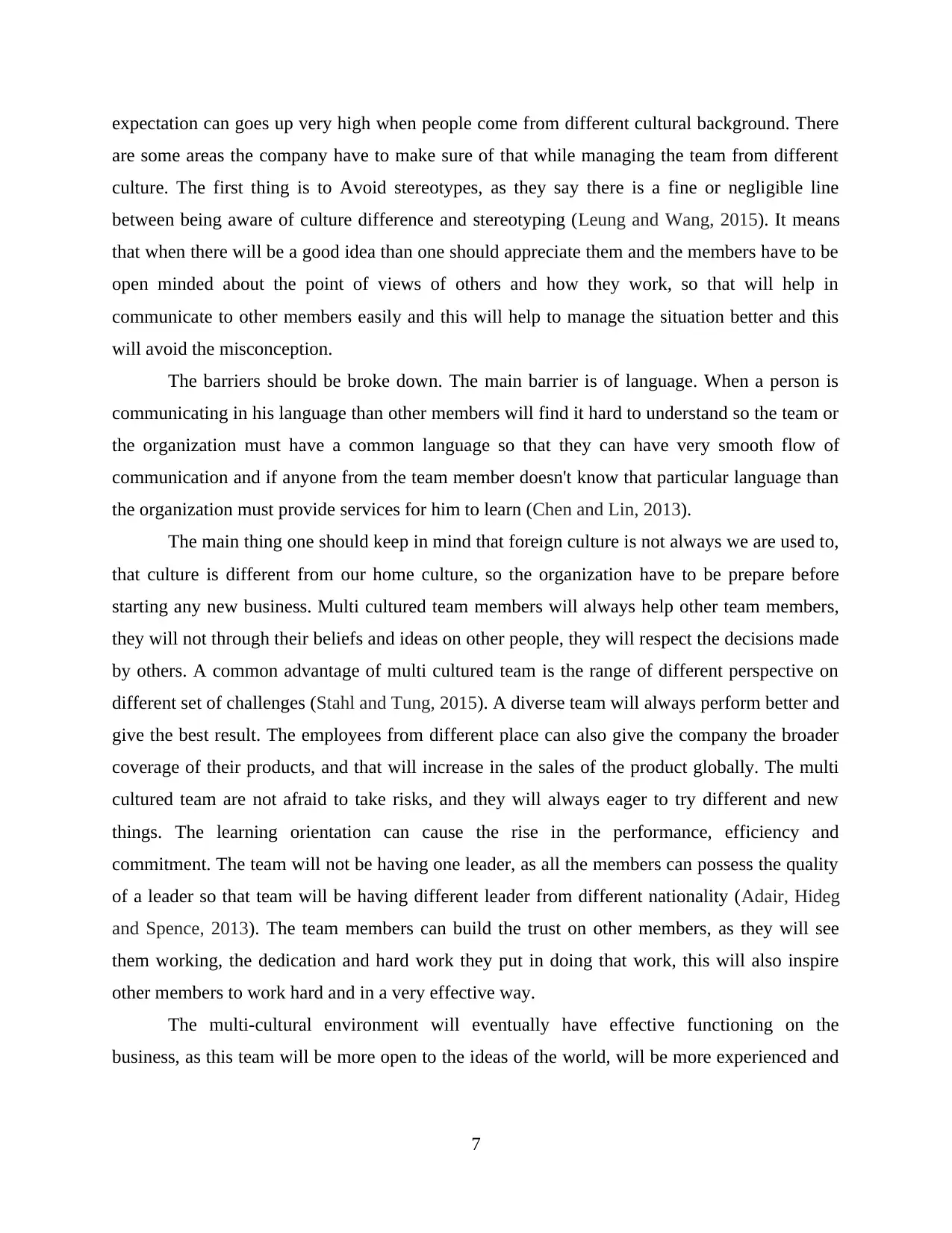
expectation can goes up very high when people come from different cultural background. There
are some areas the company have to make sure of that while managing the team from different
culture. The first thing is to Avoid stereotypes, as they say there is a fine or negligible line
between being aware of culture difference and stereotyping (Leung and Wang, 2015). It means
that when there will be a good idea than one should appreciate them and the members have to be
open minded about the point of views of others and how they work, so that will help in
communicate to other members easily and this will help to manage the situation better and this
will avoid the misconception.
The barriers should be broke down. The main barrier is of language. When a person is
communicating in his language than other members will find it hard to understand so the team or
the organization must have a common language so that they can have very smooth flow of
communication and if anyone from the team member doesn't know that particular language than
the organization must provide services for him to learn (Chen and Lin, 2013).
The main thing one should keep in mind that foreign culture is not always we are used to,
that culture is different from our home culture, so the organization have to be prepare before
starting any new business. Multi cultured team members will always help other team members,
they will not through their beliefs and ideas on other people, they will respect the decisions made
by others. A common advantage of multi cultured team is the range of different perspective on
different set of challenges (Stahl and Tung, 2015). A diverse team will always perform better and
give the best result. The employees from different place can also give the company the broader
coverage of their products, and that will increase in the sales of the product globally. The multi
cultured team are not afraid to take risks, and they will always eager to try different and new
things. The learning orientation can cause the rise in the performance, efficiency and
commitment. The team will not be having one leader, as all the members can possess the quality
of a leader so that team will be having different leader from different nationality (Adair, Hideg
and Spence, 2013). The team members can build the trust on other members, as they will see
them working, the dedication and hard work they put in doing that work, this will also inspire
other members to work hard and in a very effective way.
The multi-cultural environment will eventually have effective functioning on the
business, as this team will be more open to the ideas of the world, will be more experienced and
7
are some areas the company have to make sure of that while managing the team from different
culture. The first thing is to Avoid stereotypes, as they say there is a fine or negligible line
between being aware of culture difference and stereotyping (Leung and Wang, 2015). It means
that when there will be a good idea than one should appreciate them and the members have to be
open minded about the point of views of others and how they work, so that will help in
communicate to other members easily and this will help to manage the situation better and this
will avoid the misconception.
The barriers should be broke down. The main barrier is of language. When a person is
communicating in his language than other members will find it hard to understand so the team or
the organization must have a common language so that they can have very smooth flow of
communication and if anyone from the team member doesn't know that particular language than
the organization must provide services for him to learn (Chen and Lin, 2013).
The main thing one should keep in mind that foreign culture is not always we are used to,
that culture is different from our home culture, so the organization have to be prepare before
starting any new business. Multi cultured team members will always help other team members,
they will not through their beliefs and ideas on other people, they will respect the decisions made
by others. A common advantage of multi cultured team is the range of different perspective on
different set of challenges (Stahl and Tung, 2015). A diverse team will always perform better and
give the best result. The employees from different place can also give the company the broader
coverage of their products, and that will increase in the sales of the product globally. The multi
cultured team are not afraid to take risks, and they will always eager to try different and new
things. The learning orientation can cause the rise in the performance, efficiency and
commitment. The team will not be having one leader, as all the members can possess the quality
of a leader so that team will be having different leader from different nationality (Adair, Hideg
and Spence, 2013). The team members can build the trust on other members, as they will see
them working, the dedication and hard work they put in doing that work, this will also inspire
other members to work hard and in a very effective way.
The multi-cultural environment will eventually have effective functioning on the
business, as this team will be more open to the ideas of the world, will be more experienced and
7
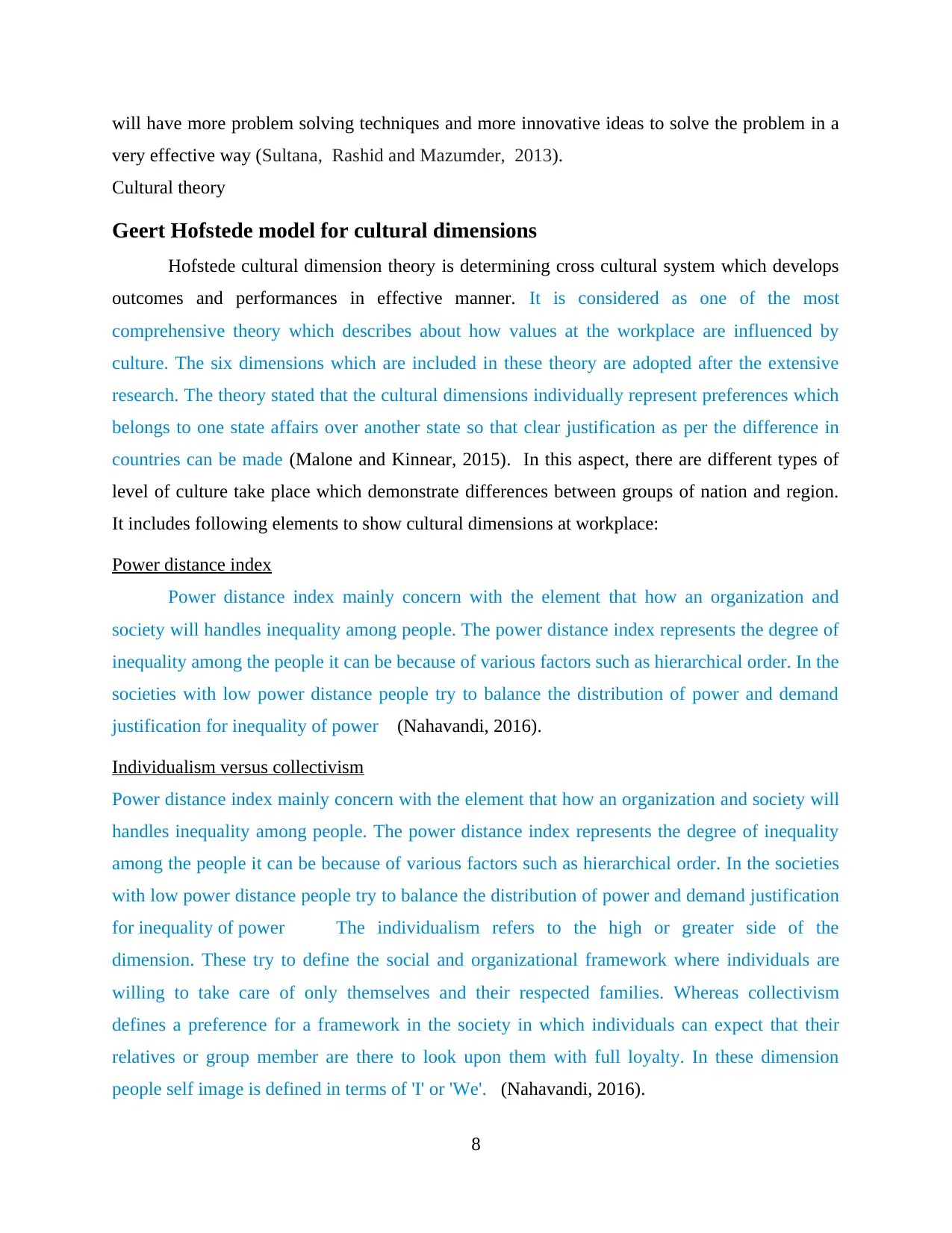
will have more problem solving techniques and more innovative ideas to solve the problem in a
very effective way (Sultana, Rashid and Mazumder, 2013).
Cultural theory
Geert Hofstede model for cultural dimensions
Hofstede cultural dimension theory is determining cross cultural system which develops
outcomes and performances in effective manner. It is considered as one of the most
comprehensive theory which describes about how values at the workplace are influenced by
culture. The six dimensions which are included in these theory are adopted after the extensive
research. The theory stated that the cultural dimensions individually represent preferences which
belongs to one state affairs over another state so that clear justification as per the difference in
countries can be made (Malone and Kinnear, 2015). In this aspect, there are different types of
level of culture take place which demonstrate differences between groups of nation and region.
It includes following elements to show cultural dimensions at workplace:
Power distance index
Power distance index mainly concern with the element that how an organization and
society will handles inequality among people. The power distance index represents the degree of
inequality among the people it can be because of various factors such as hierarchical order. In the
societies with low power distance people try to balance the distribution of power and demand
justification for inequality of power (Nahavandi, 2016).
Individualism versus collectivism
Power distance index mainly concern with the element that how an organization and society will
handles inequality among people. The power distance index represents the degree of inequality
among the people it can be because of various factors such as hierarchical order. In the societies
with low power distance people try to balance the distribution of power and demand justification
for inequality of power The individualism refers to the high or greater side of the
dimension. These try to define the social and organizational framework where individuals are
willing to take care of only themselves and their respected families. Whereas collectivism
defines a preference for a framework in the society in which individuals can expect that their
relatives or group member are there to look upon them with full loyalty. In these dimension
people self image is defined in terms of 'I' or 'We'. (Nahavandi, 2016).
8
very effective way (Sultana, Rashid and Mazumder, 2013).
Cultural theory
Geert Hofstede model for cultural dimensions
Hofstede cultural dimension theory is determining cross cultural system which develops
outcomes and performances in effective manner. It is considered as one of the most
comprehensive theory which describes about how values at the workplace are influenced by
culture. The six dimensions which are included in these theory are adopted after the extensive
research. The theory stated that the cultural dimensions individually represent preferences which
belongs to one state affairs over another state so that clear justification as per the difference in
countries can be made (Malone and Kinnear, 2015). In this aspect, there are different types of
level of culture take place which demonstrate differences between groups of nation and region.
It includes following elements to show cultural dimensions at workplace:
Power distance index
Power distance index mainly concern with the element that how an organization and
society will handles inequality among people. The power distance index represents the degree of
inequality among the people it can be because of various factors such as hierarchical order. In the
societies with low power distance people try to balance the distribution of power and demand
justification for inequality of power (Nahavandi, 2016).
Individualism versus collectivism
Power distance index mainly concern with the element that how an organization and society will
handles inequality among people. The power distance index represents the degree of inequality
among the people it can be because of various factors such as hierarchical order. In the societies
with low power distance people try to balance the distribution of power and demand justification
for inequality of power The individualism refers to the high or greater side of the
dimension. These try to define the social and organizational framework where individuals are
willing to take care of only themselves and their respected families. Whereas collectivism
defines a preference for a framework in the society in which individuals can expect that their
relatives or group member are there to look upon them with full loyalty. In these dimension
people self image is defined in terms of 'I' or 'We'. (Nahavandi, 2016).
8
⊘ This is a preview!⊘
Do you want full access?
Subscribe today to unlock all pages.

Trusted by 1+ million students worldwide
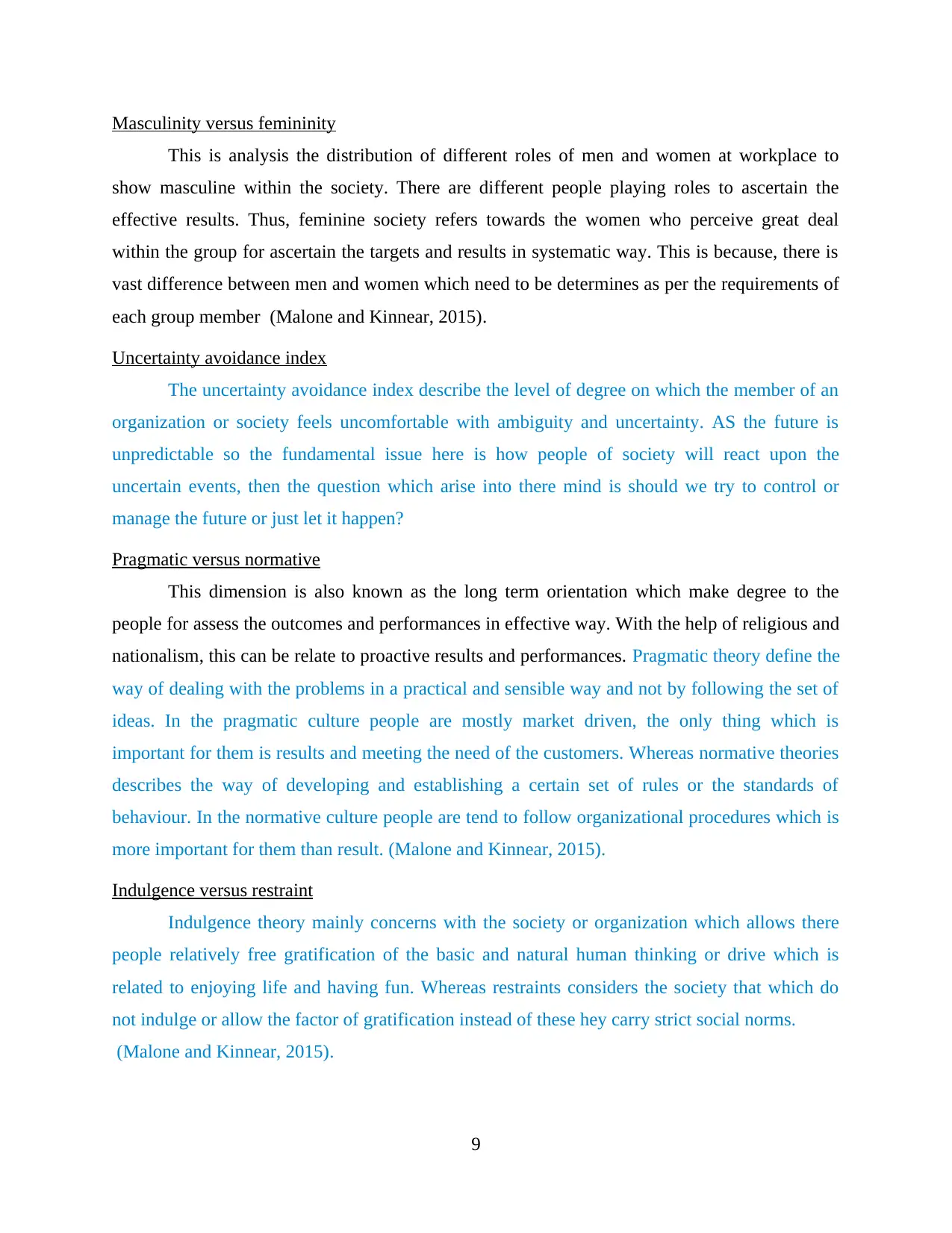
Masculinity versus femininity
This is analysis the distribution of different roles of men and women at workplace to
show masculine within the society. There are different people playing roles to ascertain the
effective results. Thus, feminine society refers towards the women who perceive great deal
within the group for ascertain the targets and results in systematic way. This is because, there is
vast difference between men and women which need to be determines as per the requirements of
each group member (Malone and Kinnear, 2015).
Uncertainty avoidance index
The uncertainty avoidance index describe the level of degree on which the member of an
organization or society feels uncomfortable with ambiguity and uncertainty. AS the future is
unpredictable so the fundamental issue here is how people of society will react upon the
uncertain events, then the question which arise into there mind is should we try to control or
manage the future or just let it happen?
Pragmatic versus normative
This dimension is also known as the long term orientation which make degree to the
people for assess the outcomes and performances in effective way. With the help of religious and
nationalism, this can be relate to proactive results and performances. Pragmatic theory define the
way of dealing with the problems in a practical and sensible way and not by following the set of
ideas. In the pragmatic culture people are mostly market driven, the only thing which is
important for them is results and meeting the need of the customers. Whereas normative theories
describes the way of developing and establishing a certain set of rules or the standards of
behaviour. In the normative culture people are tend to follow organizational procedures which is
more important for them than result. (Malone and Kinnear, 2015).
Indulgence versus restraint
Indulgence theory mainly concerns with the society or organization which allows there
people relatively free gratification of the basic and natural human thinking or drive which is
related to enjoying life and having fun. Whereas restraints considers the society that which do
not indulge or allow the factor of gratification instead of these hey carry strict social norms.
(Malone and Kinnear, 2015).
9
This is analysis the distribution of different roles of men and women at workplace to
show masculine within the society. There are different people playing roles to ascertain the
effective results. Thus, feminine society refers towards the women who perceive great deal
within the group for ascertain the targets and results in systematic way. This is because, there is
vast difference between men and women which need to be determines as per the requirements of
each group member (Malone and Kinnear, 2015).
Uncertainty avoidance index
The uncertainty avoidance index describe the level of degree on which the member of an
organization or society feels uncomfortable with ambiguity and uncertainty. AS the future is
unpredictable so the fundamental issue here is how people of society will react upon the
uncertain events, then the question which arise into there mind is should we try to control or
manage the future or just let it happen?
Pragmatic versus normative
This dimension is also known as the long term orientation which make degree to the
people for assess the outcomes and performances in effective way. With the help of religious and
nationalism, this can be relate to proactive results and performances. Pragmatic theory define the
way of dealing with the problems in a practical and sensible way and not by following the set of
ideas. In the pragmatic culture people are mostly market driven, the only thing which is
important for them is results and meeting the need of the customers. Whereas normative theories
describes the way of developing and establishing a certain set of rules or the standards of
behaviour. In the normative culture people are tend to follow organizational procedures which is
more important for them than result. (Malone and Kinnear, 2015).
Indulgence versus restraint
Indulgence theory mainly concerns with the society or organization which allows there
people relatively free gratification of the basic and natural human thinking or drive which is
related to enjoying life and having fun. Whereas restraints considers the society that which do
not indulge or allow the factor of gratification instead of these hey carry strict social norms.
(Malone and Kinnear, 2015).
9
Paraphrase This Document
Need a fresh take? Get an instant paraphrase of this document with our AI Paraphraser
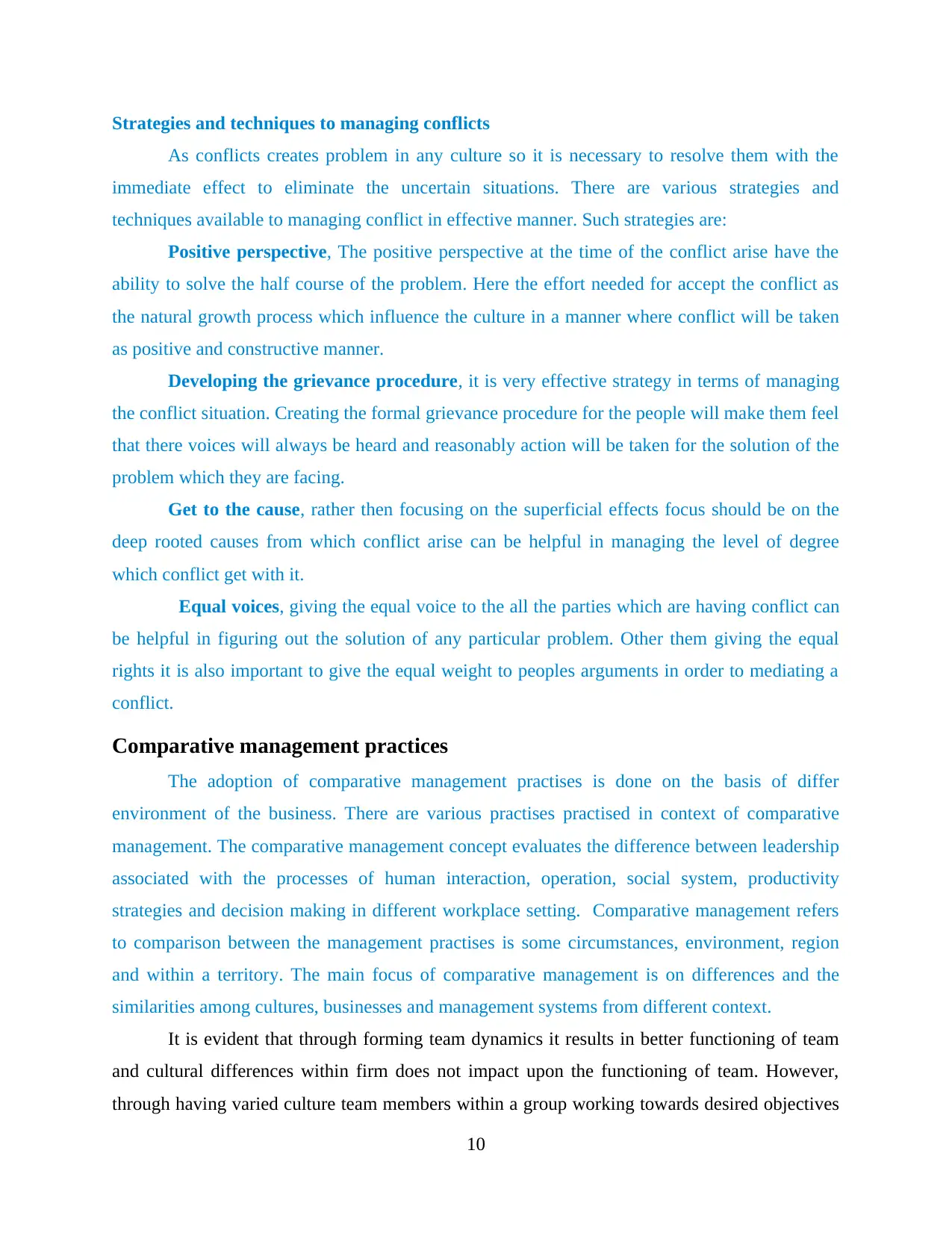
Strategies and techniques to managing conflicts
As conflicts creates problem in any culture so it is necessary to resolve them with the
immediate effect to eliminate the uncertain situations. There are various strategies and
techniques available to managing conflict in effective manner. Such strategies are:
Positive perspective, The positive perspective at the time of the conflict arise have the
ability to solve the half course of the problem. Here the effort needed for accept the conflict as
the natural growth process which influence the culture in a manner where conflict will be taken
as positive and constructive manner.
Developing the grievance procedure, it is very effective strategy in terms of managing
the conflict situation. Creating the formal grievance procedure for the people will make them feel
that there voices will always be heard and reasonably action will be taken for the solution of the
problem which they are facing.
Get to the cause, rather then focusing on the superficial effects focus should be on the
deep rooted causes from which conflict arise can be helpful in managing the level of degree
which conflict get with it.
Equal voices, giving the equal voice to the all the parties which are having conflict can
be helpful in figuring out the solution of any particular problem. Other them giving the equal
rights it is also important to give the equal weight to peoples arguments in order to mediating a
conflict.
Comparative management practices
The adoption of comparative management practises is done on the basis of differ
environment of the business. There are various practises practised in context of comparative
management. The comparative management concept evaluates the difference between leadership
associated with the processes of human interaction, operation, social system, productivity
strategies and decision making in different workplace setting. Comparative management refers
to comparison between the management practises is some circumstances, environment, region
and within a territory. The main focus of comparative management is on differences and the
similarities among cultures, businesses and management systems from different context.
It is evident that through forming team dynamics it results in better functioning of team
and cultural differences within firm does not impact upon the functioning of team. However,
through having varied culture team members within a group working towards desired objectives
10
As conflicts creates problem in any culture so it is necessary to resolve them with the
immediate effect to eliminate the uncertain situations. There are various strategies and
techniques available to managing conflict in effective manner. Such strategies are:
Positive perspective, The positive perspective at the time of the conflict arise have the
ability to solve the half course of the problem. Here the effort needed for accept the conflict as
the natural growth process which influence the culture in a manner where conflict will be taken
as positive and constructive manner.
Developing the grievance procedure, it is very effective strategy in terms of managing
the conflict situation. Creating the formal grievance procedure for the people will make them feel
that there voices will always be heard and reasonably action will be taken for the solution of the
problem which they are facing.
Get to the cause, rather then focusing on the superficial effects focus should be on the
deep rooted causes from which conflict arise can be helpful in managing the level of degree
which conflict get with it.
Equal voices, giving the equal voice to the all the parties which are having conflict can
be helpful in figuring out the solution of any particular problem. Other them giving the equal
rights it is also important to give the equal weight to peoples arguments in order to mediating a
conflict.
Comparative management practices
The adoption of comparative management practises is done on the basis of differ
environment of the business. There are various practises practised in context of comparative
management. The comparative management concept evaluates the difference between leadership
associated with the processes of human interaction, operation, social system, productivity
strategies and decision making in different workplace setting. Comparative management refers
to comparison between the management practises is some circumstances, environment, region
and within a territory. The main focus of comparative management is on differences and the
similarities among cultures, businesses and management systems from different context.
It is evident that through forming team dynamics it results in better functioning of team
and cultural differences within firm does not impact upon the functioning of team. However,
through having varied culture team members within a group working towards desired objectives
10
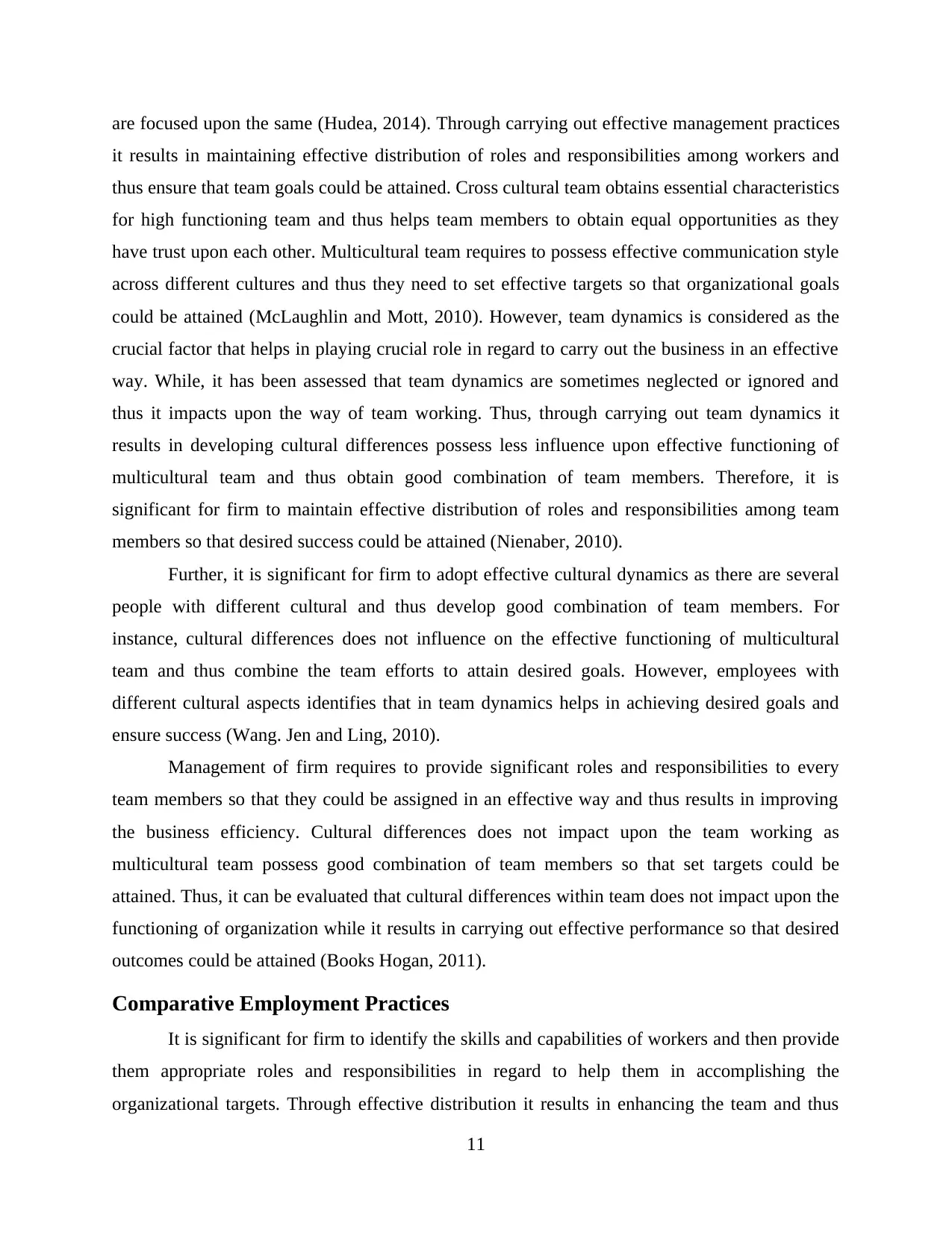
are focused upon the same (Hudea, 2014). Through carrying out effective management practices
it results in maintaining effective distribution of roles and responsibilities among workers and
thus ensure that team goals could be attained. Cross cultural team obtains essential characteristics
for high functioning team and thus helps team members to obtain equal opportunities as they
have trust upon each other. Multicultural team requires to possess effective communication style
across different cultures and thus they need to set effective targets so that organizational goals
could be attained (McLaughlin and Mott, 2010). However, team dynamics is considered as the
crucial factor that helps in playing crucial role in regard to carry out the business in an effective
way. While, it has been assessed that team dynamics are sometimes neglected or ignored and
thus it impacts upon the way of team working. Thus, through carrying out team dynamics it
results in developing cultural differences possess less influence upon effective functioning of
multicultural team and thus obtain good combination of team members. Therefore, it is
significant for firm to maintain effective distribution of roles and responsibilities among team
members so that desired success could be attained (Nienaber, 2010).
Further, it is significant for firm to adopt effective cultural dynamics as there are several
people with different cultural and thus develop good combination of team members. For
instance, cultural differences does not influence on the effective functioning of multicultural
team and thus combine the team efforts to attain desired goals. However, employees with
different cultural aspects identifies that in team dynamics helps in achieving desired goals and
ensure success (Wang. Jen and Ling, 2010).
Management of firm requires to provide significant roles and responsibilities to every
team members so that they could be assigned in an effective way and thus results in improving
the business efficiency. Cultural differences does not impact upon the team working as
multicultural team possess good combination of team members so that set targets could be
attained. Thus, it can be evaluated that cultural differences within team does not impact upon the
functioning of organization while it results in carrying out effective performance so that desired
outcomes could be attained (Books Hogan, 2011).
Comparative Employment Practices
It is significant for firm to identify the skills and capabilities of workers and then provide
them appropriate roles and responsibilities in regard to help them in accomplishing the
organizational targets. Through effective distribution it results in enhancing the team and thus
11
it results in maintaining effective distribution of roles and responsibilities among workers and
thus ensure that team goals could be attained. Cross cultural team obtains essential characteristics
for high functioning team and thus helps team members to obtain equal opportunities as they
have trust upon each other. Multicultural team requires to possess effective communication style
across different cultures and thus they need to set effective targets so that organizational goals
could be attained (McLaughlin and Mott, 2010). However, team dynamics is considered as the
crucial factor that helps in playing crucial role in regard to carry out the business in an effective
way. While, it has been assessed that team dynamics are sometimes neglected or ignored and
thus it impacts upon the way of team working. Thus, through carrying out team dynamics it
results in developing cultural differences possess less influence upon effective functioning of
multicultural team and thus obtain good combination of team members. Therefore, it is
significant for firm to maintain effective distribution of roles and responsibilities among team
members so that desired success could be attained (Nienaber, 2010).
Further, it is significant for firm to adopt effective cultural dynamics as there are several
people with different cultural and thus develop good combination of team members. For
instance, cultural differences does not influence on the effective functioning of multicultural
team and thus combine the team efforts to attain desired goals. However, employees with
different cultural aspects identifies that in team dynamics helps in achieving desired goals and
ensure success (Wang. Jen and Ling, 2010).
Management of firm requires to provide significant roles and responsibilities to every
team members so that they could be assigned in an effective way and thus results in improving
the business efficiency. Cultural differences does not impact upon the team working as
multicultural team possess good combination of team members so that set targets could be
attained. Thus, it can be evaluated that cultural differences within team does not impact upon the
functioning of organization while it results in carrying out effective performance so that desired
outcomes could be attained (Books Hogan, 2011).
Comparative Employment Practices
It is significant for firm to identify the skills and capabilities of workers and then provide
them appropriate roles and responsibilities in regard to help them in accomplishing the
organizational targets. Through effective distribution it results in enhancing the team and thus
11
⊘ This is a preview!⊘
Do you want full access?
Subscribe today to unlock all pages.

Trusted by 1+ million students worldwide
1 out of 17
Related Documents
Your All-in-One AI-Powered Toolkit for Academic Success.
+13062052269
info@desklib.com
Available 24*7 on WhatsApp / Email
![[object Object]](/_next/static/media/star-bottom.7253800d.svg)
Unlock your academic potential
Copyright © 2020–2025 A2Z Services. All Rights Reserved. Developed and managed by ZUCOL.





